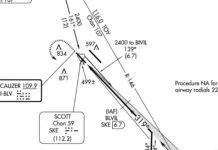The whole thing started when a reader asked about an approach to a Runway 26 that had the note, “Rwy 26 Straight-in and Circling minimums NA at night.”
“Why doesn’t it just say the approach is NA at night?” the reader asked. We agreed that’s what it seemed to say, but we also wondered why it was said in so awkward a manner. So, we investigated and the answer we found surprised all of us.
Some Basics
Before we get to the original question, let’s talk a bit about circling and circling minimums. First, they are two different things. A circle-to-land means that you might be approaching one runway, but you won’t land straight in; instead you’ll circle—usually, but not always, to a different runway. So, in the case of an approach to Runway 26, circling means that you might land on Runway 08 or indeed still on Runway 26, but only after circling.
One reason you might need to circle back to Runway 26 on this Runway 26 approach instead of landing straight in is that the minimums leave you too high for a straight-in landing as required by 91.175. So, in this case, you’ll fly a full pattern—upwind, crosswind, downwind, base, and final—losing altitude as needed before you make a normal landing.
Circling minimums are the minimums that must exist before you can perform that circling maneuver. In this case, they’re just minimums though. Circling minimums don’t preclude landing straight in, if you can do so with the normal maneuvers required by 91.175. But circling minimums are the lowest you can go if you aren’t landing straight in regardless of the runway you’ll ultimately use.
Let’s look at a way to make this last part a little simpler. Say you’re flying the VOR A approach. That’s not sufficiently aligned with a runway to have an identified runway in the name. So, it’s also only got circling minimums.
But, let’s say that Runway 33 is only a bit off the straight-in from this approach and it’s a simple matter to jog over and land on Runway 33 once you break out. That’s reasonable, right? We often do that. Well, landing straight in from the circling minimums on a runway-named approach is equally reasonable and is absolutely permitted.
That’s it. You can circle to any runway, including the approach’s named runway. Circling minimums are simply those minimums that must be used for circling, but they don’t preclude landing straight in. Got that?
Confusing Note

Now back to our confusing note, “Rwy 26 Straight-in and Circling minimums NA at night.” First thing we need to straighten out is that this does not mean you can’t fly the approach at night. If they wanted it so you couldn’t use the approach at all at night, the note would simply read, “Procedure NA at night.” That’s pretty straightforward and doesn’t leave any room for interpretation.
So, if that’s not what the note means, we’ve got to dig deeper to try to figure out what it does mean. Keep in mind that this is a note on an approach to Runway 26. The obvious decoding of that note is that since at night you can’t use the Runway 26 straight-in minimums, and you can’t use the Runway 26 circling minimums on this Runway 26 approach, that you can’t use this approach at night. Obvious, yes. Correct? No.
The answer that our friends at the FAA told us, only makes sense to us now that we know what it means. Follow along: “Runway 26 straight in minimums NA at night,” means, as you’d expect, that you can’t land straight in to the named runway on this approach. That part’s easy.
But, “Runway 26 circling minimums NA at night,” doesn’t mean that the minimums themselves are NA. Instead, it means you can’t use those minimums to land on Runway 26. But, that leaves open the possibility that you can use the approach’s circling minimums to land on Runway 8 at night.
Similar notes exist on other approaches. While they’re not common, but neither are they unheard of. The lesson we learned is that if a note sounds odd and doesn’t make sense as written, you just might be interpreting it incorrectly. Incidentally, the FAA folks we talked with found the wording awkward enough that they’re looking into changing it to clarify the meaning.
(As our friends at the FAA dug into this, they discovered other issues with the approaches to this airport. So, use this example only as discussed in the article.)





